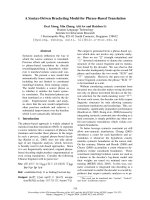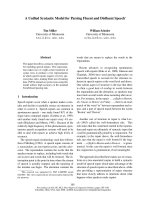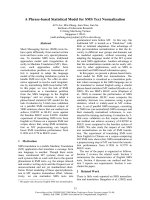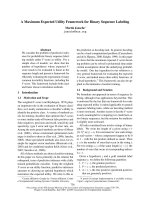Báo cáo khoa học: "A Feature-Rich Constituent Context Model for Grammar Induction" doc
Bạn đang xem bản rút gọn của tài liệu. Xem và tải ngay bản đầy đủ của tài liệu tại đây (209.41 KB, 6 trang )
Proceedings of the 50th Annual Meeting of the Association for Computational Linguistics, pages 17–22,
Jeju, Republic of Korea, 8-14 July 2012.
c
2012 Association for Computational Linguistics
A Feature-Rich Constituent Context Model for Grammar Induction
Dave Golland
University of California, Berkeley
John DeNero
Google
Jakob Uszkoreit
Google
Abstract
We present LLCCM, a log-linear variant of the
constituent context model (CCM) of grammar
induction. LLCCM retains the simplicity of
the original CCM but extends robustly to long
sentences. On sentences of up to length 40,
LLCCM outperforms CCM by 13.9% brack-
eting F1 and outperforms a right-branching
baseline in regimes where CCM does not.
1 Introduction
Unsupervised grammar induction is a fundamental
challenge of statistical natural language processing
(Lari and Young, 1990; Pereira and Schabes, 1992;
Carroll and Charniak, 1992). The constituent con-
text model (CCM) for inducing constituency parses
(Klein and Manning, 2002) was the first unsuper-
vised approach to surpass a right-branching base-
line. However, the CCM only effectively models
short sentences. This paper shows that a simple re-
parameterization of the model, which ties together
the probabilities of related events, allows the CCM
to extend robustly to long sentences.
Much recent research has explored dependency
grammar induction. For instance, the dependency
model with valence (DMV) of Klein and Manning
(2004) has been extended to utilize multilingual in-
formation (Berg-Kirkpatrick and Klein, 2010; Co-
hen et al., 2011), lexical information (Headden III et
al., 2009), and linguistic universals (Naseem et al.,
2010). Nevertheless, simplistic dependency models
like the DMV do not contain information present in
a constituency parse, such as the attachment order of
object and subject to a verb.
Unsupervised constituency parsing is also an ac-
tive research area. Several studies (Seginer, 2007;
Reichart and Rappoport, 2010; Ponvert et al., 2011)
have considered the problem of inducing parses
over raw lexical items rather than part-of-speech
(POS) tags. Additional advances have come from
more complex models, such as combining CCM
and DMV (Klein and Manning, 2004) and model-
ing large tree fragments (Bod, 2006).
The CCM scores each parse as a product of prob-
abilities of span and context subsequences. It was
originally evaluated only on unpunctuated sentences
up to length 10 (Klein and Manning, 2002), which
account for only 15% of the WSJ corpus; our exper-
iments confirm the observation in (Klein, 2005) that
performance degrades dramatically on longer sen-
tences. This problem is unsurprising: CCM scores
each constituent type by a single, isolated multino-
mial parameter.
Our work leverages the idea that sharing infor-
mation between local probabilities in a structured
unsupervised model can lead to substantial accu-
racy gains, previously demonstrated for dependency
grammar induction (Cohen and Smith, 2009; Berg-
Kirkpatrick et al., 2010). Our model, Log-Linear
CCM (LLCCM), shares information between the
probabilities of related constituents by expressing
them as a log-linear combination of features trained
using the gradient-based learning procedure of Berg-
Kirkpatrick et al. (2010). In this way, the probabil-
ity of generating a constituent is informed by related
constituents.
Our model improves unsupervised constituency
parsing of sentences longer than 10 words. On sen-
tences of up to length 40 (96% of all sentences in
the Penn Treebank), LLCCM outperforms CCM by
13.9% (unlabeled) bracketing F1 and, unlike CCM,
outperforms a right-branching baseline on sentences
longer than 15 words.
17
2 Model
The CCM is a generative model for the unsuper-
vised induction of binary constituency parses over
sequences of part-of-speech (POS) tags (Klein and
Manning, 2002). Conditioned on the constituency or
distituency of each span in the parse, CCM generates
both the complete sequence of terminals it contains
and the terminals in the surrounding context.
Formally, the CCM is a probabilistic model that
jointly generates a sentence, s, and a bracketing,
B, specifying whether each contiguous subsequence
is a constituent or not, in which case the span is
called a distituent. Each subsequence of POS tags,
or SPAN, α, occurs in a CONTEXT, β, which is an
ordered pair of preceding and following tags. A
bracketing is a boolean matrix B, indicating which
spans (i, j) are constituents (B
ij
= true) and which
are distituents (B
ij
= f alse). A bracketing is con-
sidered legal if its constituents are nested and form a
binary tree T (B).
The joint distribution is given by:
P(s, B) = P
T
(B) ·
i,j∈T (B)
P
S
(α(i, j, s)|true) P
C
(β(i, j, s)|true) ·
i,j∈T (B)
P
S
(α(i, j, s)|false) P
C
(β(i, j, s)|false)
The prior over unobserved bracketings P
T
(B) is
fixed to be the uniform distribution over all legal
bracketings. The other distributions, P
S
(·) and
P
C
(·), are multinomials whose isolated parameters
are estimated to maximize the likelihood of a set of
observed sentences {s
n
} using EM (Dempster et al.,
1977).
1
2.1 The Log-Linear CCM
A fundamental limitation of the CCM is that it con-
tains a single isolated parameter for every span. The
number of different possible span types increases ex-
ponentially in span length, leading to data sparsity as
the sentence length increases.
1
As mentioned in (Klein and Manning, 2002), the CCM
model is deficient because it assigns probability mass to yields
and spans that cannot consistently combine to form a valid sen-
tence. Our model does not address this issue, and hence it is
similarly deficient.
The Log-Linear CCM (LLCCM) reparameterizes
the distributions in the CCM using intuitive features
to address the limitations of CCM while retaining
its predictive power. The set of proposed features
includes a BASIC feature for each parameter of the
original CCM, enabling the LLCCM to retain the
full expressive power of the CCM. In addition, LL-
CCM contains a set of coarse features that activate
across distinct spans.
To introduce features into the CCM, we express
each of its local conditional distributions as a multi-
class logistic regression model. Each local distri-
bution, P
t
(y|x) for t ∈ {SPAN, CONTEXT}, condi-
tions on label x ∈ {true, false} and generates an
event (span or context) y. We can define each lo-
cal distribution in terms of a weight vector, w, and
feature vector, f
xyt
, using a log-linear model:
P
t
(y|x) =
exp w, f
xyt
y
exp
w, f
xy
t
(1)
This technique for parameter transformation was
shown to be effective in unsupervised models for
part-of-speech induction, dependency grammar in-
duction, word alignment, and word segmentation
(Berg-Kirkpatrick et al., 2010). In our case, replac-
ing multinomials via featurized models not only im-
proves model accuracy, but also lets the model apply
effectively to a new regime of long sentences.
2.2 Feature Templates
In the SPAN model, for each span y = [α
1
, . . . , α
n
]
and label x, we use the following feature templates:
BASIC: I [y = · ∧ x = ·]
BOUNDARY: I [α
1
= · ∧ α
n
= · ∧ x = ·]
PREFIX: I [α
1
= · ∧ x = ·]
SUFFIX: I [α
n
= · ∧ x = ·]
Just as the external CONTEXT is a signal of con-
stituency, so too is the internal “context.” For exam-
ple, there are many distinct noun phrases with differ-
ent spans that all begin with DT and end with NN; a
fact expressed by the BOUNDARY feature (Table 1).
In the CONTEXT model, for each context y =
[β
1
, β
2
] and constituent/distituent decision x, we use
the following feature templates:
BASIC: I [y = · ∧ x = ·]
L-CONTEXT: I [β
1
= · ∧ x = ·]
R-CONTEXT: I [β
2
= · ∧ x = ·]
18
Consider the following example extracted from
the WSJ:
0
The
1
DT
Venezuelan
2
JJ
currency
3
NN
NP-SBJ
plummeted
4
VBD
this
5
DT
year
6
NN
NP-TMP
VP
S
Both spans (0, 3) and (4, 6) are constituents corre-
sponding to noun phrases whose features are shown
in Table 1:
Feature Name (0,3) (4, 6)
span
BASIC-DT-JJ-NN: 1 0
BASIC-DT-NN: 0 1
BOUNDARY-DT-NN: 1 1
PREFIX-DT: 1 1
SUFFIX-NN: 1 1
context
BASIC--VBD: 1 0
BASIC-VBD-: 0 1
L-CONTEXT-: 1 0
L-CONTEXT-VBD: 0 1
R-CONTEXT-VBD: 1 0
R-CONTEXT-: 0 1
Table 1: Span and context features for constituent spans (0, 3)
and (4, 6). The symbol indicates a sentence boundary.
Notice that although the BASIC span features are
active for at most one span, the remaining features
fire for both spans, effectively sharing information
between the local probabilities of these events.
The coarser CONTEXT features factor the context
pair into its components, which allow the LLCCM
to more easily learn, for example, that a constituent
is unlikely to immediately follow a determiner.
3 Training
In the EM algorithm for estimating CCM parame-
ters, the E-Step computes posteriors over bracket-
ings using the Inside-Outside algorithm. The M-
Step chooses parameters that maximize the expected
complete log likelihood of the data.
The weights, w, of LLCCM are estimated to max-
imize the data log likelihood of the training sen-
tences {s
n
}, summing out all possible bracketings
B for each sentence:
L(w) =
s
n
log
B
P
w
(s
n
, B)
We optimize this objective via L-BFGS (Liu and
Nocedal, 1989), which requires us to compute the
objective gradient. Berg-Kirkpatrick et al. (2010)
showed that the data log likelihood gradient is equiv-
alent to the gradient of the expected complete log
likelihood (the objective maximized in the M-step of
EM) at the point from which expectations are com-
puted. This gradient can be computed in three steps.
First, we compute the local probabilities of the
CCM, P
t
(y|x), from the current w using Equa-
tion (1). We approximate the normalization over an
exponential number of terms by only summing over
spans that appeared in the training corpus.
Second, we compute posteriors over bracketings,
P(i, j|s
n
), just as in the E-step of CCM training,
2
in
order to determine the expected counts:
e
xy,SPAN
=
s
n
ij
I [α(i, j, s
n
) = y] δ(x)
e
xy,CONTEXT
=
s
n
ij
I [β(i, j, s
n
) = y] δ(x)
where δ(true) = P(i, j|s
n
), and δ(false) = 1 −
δ(true).
We summarize these expected count quantities as:
e
xyt
=
e
xy,SPAN
if t = SPAN
e
xy,CONTEXT
if t = CONTEXT
Finally, we compute the gradient with respect to
w, expressed in terms of these expected counts and
conditional probabilities:
∇L(w) =
xyt
e
xyt
f
xyt
− G(w)
G(w) =
xt
y
e
xyt
y
P
t
(y|x)f
xy
t
Following (Klein and Manning, 2002), we initialize
the model weights by optimizing against posterior
probabilities fixed to the split-uniform distribution,
which generates binary trees by randomly choosing
a split point and recursing on each side of the split.
3
2
We follow the dynamic program presented in Appendix A.1
of (Klein, 2005).
3
In Appendix B.2, Klein (2005) shows this posterior can be
expressed in closed form. As in previous work, we start the ini-
tialization optimization with the zero vector, and terminate after
10 iterations to regularize against achieving a local maximum.
19
3.1 Efficiently Computing the Gradient
The following quantity appears in G(w):
γ
t
(x) =
y
e
xyt
Which expands as follows depending on t:
γ
SPAN
(x) =
y
s
n
ij
I [α(i, j, s
n
) = y] δ(x)
γ
CONTEXT
(x) =
y
s
n
ij
I [β(i, j, s
n
) = y] δ(x)
In each of these expressions, the δ(x) term can
be factored outside the sum over y. Each fixed
(i, j) and s
n
pair has exactly one span and con-
text, hence the quantities
y
I [α(i, j, s
n
) = y] and
y
I [β(i, j, s
n
) = y] are both equal to 1.
γ
t
(x) =
s
n
ij
δ(x)
This expression further simplifies to a constant.
The sum of the posterior probabilities, δ(true), over
all positions is equal to the total number of con-
stituents in the tree. Any binary tree over N ter-
minals contains exactly 2N − 1 constituents and
1
2
(N − 2)(N − 1) distituents.
γ
t
(x) =
s
n
(2|s
n
| − 1) if x = true
1
2
s
n
(|s
n
| − 2)(|s
n
| − 1) if x = f alse
where |s
n
| denotes the length of sentence s
n
.
Thus, G(w) can be precomputed once for the en-
tire dataset at each minimization step. Moreover,
γ
t
(x) can be precomputed once before all iterations.
3.2 Relationship to Smoothing
The original CCM uses additive smoothing in its M-
step to capture the fact that distituents outnumber
constituents. For each span or context, CCM adds
10 counts: 2 as a constituent and 8 as a distituent.
4
We note that these smoothing parameters are tai-
lored to short sentences: in a binary tree, the number
of constituents grows linearly with sentence length,
whereas the number of distituents grows quadrati-
cally. Therefore, the ratio of constituents to dis-
tituents is not constant across sentence lengths. In
contrast, by virtue of the log-linear model, LLCCM
assigns positive probability to all spans or contexts
without explicit smoothing.
4
These counts are specified in (Klein, 2005); Klein and
Manning (2002) added 10 constituent and 50 distituent counts.
Length
Baseline
CCM
LLCCM
Right
branching
Upper
bound
Initialization
10
15
20
25
30
35
40
71.9
72.0
61.7
88.1
49.8
53.0
64.6
53.1
86.8
39.8
46.6
60.0
48.2
86.3
34.2
42.7
56.2
44.9
85.9
30.6
39.9
50.3
42.6
85.7
28.5
37.5
49.2
41.3
85.6
27.3
33.7
47.6
40.5
85.5
26.8
0
25
50
75
100
10 15 20 25 30 35 40
72.0
64.6
60.0
56.2
50.3
49.2
47.6
71.9
53.0
46.6
42.7
39.9
37.5
33.7
Binary branching upper bound
Log-linear CCM
Standard CCM
Right branching
Maximum sentence length
Bracketing F1
Figure 1: CCM and LLCCM trained and tested on sentences of
a fixed length. LLCCM performs well on longer sentences. The
binary branching upper bound correponds to UBOUND from
(Klein and Manning, 2002).
4 Experiments
We train our models on gold POS sequences from
all sections (0-24) of the WSJ (Marcus et al., 1993)
with punctuation removed. We report bracketing
F1 scores between the binary trees predicted by the
models on these sequences and the treebank parses.
We train and evaluate both a CCM implementa-
tion (Luque, 2011) and our LLCCM on sentences up
to a fixed length n, for n ∈ {10, 15, . . . , 40}. Fig-
ure 1 shows that LLCCM substantially outperforms
the CCM on longer sentences. After length 15,
CCM accuracy falls below the right branching base-
line, whereas LLCCM remains significantly better
than right-branching through length 40.
5 Conclusion
Our log-linear variant of the CCM extends robustly
to long sentences, enabling constituent grammar in-
duction to be used in settings that typically include
long sentences, such as machine translation reorder-
ing (Chiang, 2005; DeNero and Uszkoreit, 2011;
Dyer et al., 2011).
Acknowledgments
We thank Taylor Berg-Kirkpatrick and Dan Klein
for helpful discussions regarding the work on which
this paper is based. This work was partially sup-
ported by the National Science Foundation through
a Graduate Research Fellowship to the first author.
20
References
Taylor Berg-Kirkpatrick and Dan Klein. 2010. Phyloge-
netic grammar induction. In Proceedings of the 48th
Annual Meeting of the Association for Computational
Linguistics, pages 1288–1297, Uppsala, Sweden, July.
Association for Computational Linguistics.
Taylor Berg-Kirkpatrick, Alexandre Bouchard-C
ˆ
ot
´
e,
John DeNero, and Dan Klein. 2010. Painless unsu-
pervised learning with features. In Human Language
Technologies: The 2010 Annual Conference of the
North American Chapter of the Association for Com-
putational Linguistics, pages 582–590, Los Angeles,
California, June. Association for Computational Lin-
guistics.
Rens Bod. 2006. Unsupervised parsing with U-DOP.
In Proceedings of the Conference on Computational
Natural Language Learning.
Glenn Carroll and Eugene Charniak. 1992. Two experi-
ments on learning probabilistic dependency grammars
from corpora. In Workshop Notes for Statistically-
Based NLP Techniques, AAAI, pages 1–13.
David Chiang. 2005. A hierarchical phrase-based model
for statistical machine translation. In Proceedings of
the 43rd Annual Meeting of the Association for Com-
putational Linguistics, pages 263–270, Ann Arbor,
Michigan, June. Association for Computational Lin-
guistics.
Shay B. Cohen and Noah A. Smith. 2009. Shared logis-
tic normal distributions for soft parameter tying in un-
supervised grammar induction. In Proceedings of Hu-
man Language Technologies: The 2009 Annual Con-
ference of the North American Chapter of the Asso-
ciation for Computational Linguistics, pages 74–82,
Boulder, Colorado, June. Association for Computa-
tional Linguistics.
Shay B. Cohen, Dipanjan Das, and Noah A. Smith. 2011.
Unsupervised structure prediction with non-parallel
multilingual guidance. In Proceedings of the 2011
Conference on Empirical Methods in Natural Lan-
guage Processing, pages 50–61, Edinburgh, Scotland,
UK., July. Association for Computational Linguistics.
Arthur Dempster, Nan Laird, and Donald Rubin. 1977.
Maximum likelihood from incomplete data via the EM
algorithm. Journal of the Royal Statistical Society. Se-
ries B (Methodological), 39(1):1–38.
John DeNero and Jakob Uszkoreit. 2011. Inducing sen-
tence structure from parallel corpora for reordering.
In Proceedings of the 2011 Conference on Empirical
Methods in Natural Language Processing, pages 193–
203, Edinburgh, Scotland, UK., July. Association for
Computational Linguistics.
Chris Dyer, Kevin Gimpel, Jonathan H. Clark, and
Noah A. Smith. 2011. The CMU-ARK German-
English translation system. In Proceedings of the Sixth
Workshop on Statistical Machine Translation, pages
337–343, Edinburgh, Scotland, July. Association for
Computational Linguistics.
William P. Headden III, Mark Johnson, and David Mc-
Closky. 2009. Improving unsupervised dependency
parsing with richer contexts and smoothing. In Pro-
ceedings of Human Language Technologies: The 2009
Annual Conference of the North American Chapter of
the Association for Computational Linguistics, pages
101–109, Boulder, Colorado, June. Association for
Computational Linguistics.
Dan Klein and Christopher D. Manning. 2002. A gener-
ative constituent-context model for improved grammar
induction. In Proceedings of 40th Annual Meeting of
the Association for Computational Linguistics, pages
128–135, Philadelphia, Pennsylvania, USA, July. As-
sociation for Computational Linguistics.
Dan Klein and Christopher D. Manning. 2004. Corpus-
based induction of syntactic structure: Models of de-
pendency and constituency. In Proceedings of the
42nd Meeting of the Association for Computational
Linguistics, Main Volume, pages 478–485, Barcelona,
Spain, July.
Dan Klein. 2005. The Unsupervised Learning of Natural
Language Structure. Ph.D. thesis.
Karim Lari and Steve J. Young. 1990. The estimation
of stochastic context-free grammars using the inside-
outside algorithm. Computer Speech and Language,
4:35–56.
Dong C. Liu and Jorge Nocedal. 1989. On the limited
memory method for large scale optimization. Mathe-
matical Programming B, 45(3):503–528.
Franco Luque. 2011. Una implementaci
´
on del mod-
elo DMV+CCM para parsing no supervisado. In 2do
Workshop Argentino en Procesamiento de Lenguaje
Natural.
Mitchell P. Marcus, Beatrice Santorini, and Mary A.
Marcinkiewicz. 1993. Building a Large Annotated
Corpus of English: The Penn Treebank. Computa-
tional Linguistics, 19(2):313–330.
Tahira Naseem and Regina Barzilay. 2011. Using se-
mantic cues to learn syntax. In AAAI.
Tahira Naseem, Harr Chen, Regina Barzilay, and Mark
Johnson. 2010. Using universal linguistic knowl-
edge to guide grammar induction. In Proceedings of
the 2010 Conference on Empirical Methods in Natural
Language Processing, pages 1234–1244, Cambridge,
MA, October. Association for Computational Linguis-
tics.
Fernando Pereira and Yves Schabes. 1992. Inside-
outside reestimation from partially bracketed corpora.
21
In Proceedings of the 30th Annual Meeting of the As-
sociation for Computational Linguistics, pages 128–
135, Newark, Delaware, USA, June. Association for
Computational Linguistics.
Elias Ponvert, Jason Baldridge, and Katrin Erk. 2011.
Simple unsupervised grammar induction from raw text
with cascaded finite state models. In Proceedings of
the 49th Annual Meeting of the Association for Com-
putational Linguistics: Human Language Technolo-
gies, pages 1077–1086, Portland, Oregon, USA, June.
Association for Computational Linguistics.
Roi Reichart and Ari Rappoport. 2010. Improved fully
unsupervised parsing with zoomed learning. In Pro-
ceedings of the 2010 Conference on Empirical Meth-
ods in Natural Language Processing, pages 684–693,
Cambridge, MA, October. Association for Computa-
tional Linguistics.
Yoav Seginer. 2007. Fast unsupervised incremental pars-
ing. In Proceedings of the 45th Annual Meeting of the
Association of Computational Linguistics, pages 384–
391, Prague, Czech Republic, June. Association for
Computational Linguistics.
22









